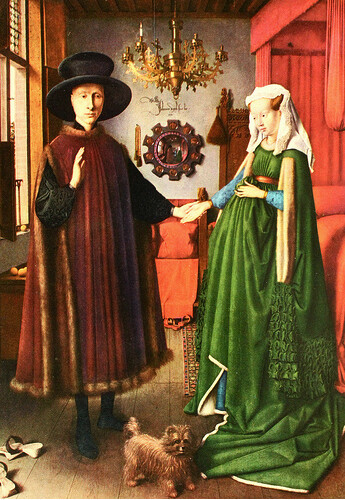The Northern Renaissance is a much less complex period of art history in comparison to the Italian Renaissance, lasting for only a century in contrast to the three hundred years of the Italian branch of the movement and spread of art. However, around the same time that Renaissance art was beginning to flourish in Italy, a parallel art movement was taking root throughout Northern Europe. Rather than a "rebirth" the Northern Renaissance was seen as "reinvigorating" the art from the past - working almost exclusively in the new media of oil painting.
Painting Practices
By the time of the Northern Renaissance, art had become independent of it's environment and had become "art for art's sake" rather than used for design or decoration, this began the still common trend of painting using an easel. An example of taking an artwork and creating it away from it's local environment, is St. Jerome in a Rocky Landscape by Joachim Patenier, completed in 1524. This image, along with others by Patenier, depict him as the first artist to embrace the painting of landscapes to be displayed independently from the environment. This allowed for extensive themes within a painting and also encouraged the spread of oil paintings throughout Europe.
| "St. Jerome in a Rocky Landscape" by Joachim Patenier, completed by 1524 with oil on easel painting. |
 |
| "The Arnolfini Portrait" Oil Painting by Jan Van Eyck completed in 1434. |
Oil Painting
The use of oils in order to change painting technique changed the way that we paint, it provided an unprecedented clarity that could not have been achieved by earlier means and made the creation of crisp and vibrant colours easier to produce, paint was now more widely available with access as painters did not have the same difficulty in manufacturing paint. This was particularly highlighted in the work of Jan Van Eyck which alludes to a hyper realism that would not be revisited again for centuries to come.
Oil painting also allowed for an easier depiction of the effects of light upon detail as shown in the above Arnolfini Portrait which shows an immense clarity in it's observation of the chandelier and light streaming in through the window. Oil paints only serve this method further in his painting Man in a Turban in 1433. This new application of material by paint meant that the bridge between Northern Renaissance and Baroque was beginning to formulate.
Other key members of the Northern Renaissance period of art include Rogier van der Weyden, considered to be the most influential painter of the time, e.g. a prominent artwork being The Descent from the Cross c. 1435.
In conclusion, the Northern Renaissance provided a different branch of the Renaissance for the Low Countries of Northern Europe. It looked at the finer and more ornate details in a painting and revolutionized the environment and the ease of painting with oil paints and the introduction of the easel, this made it easier for artists such as Campin, Bouts and Memling utilized these materials for their advantage, providing a parallel between the Renaissance and the Northern Renaissance.


0 comments:
Post a Comment